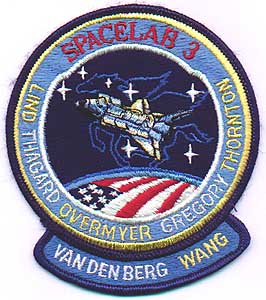
|
|

| Crew & Mission |
|
The Orbiter Challenger lifted off from Pad A, Launch Complex 39, KSC, at 12:02 p.m. EDT on April 29, 1985. This was the second flight of Spacelab, the first in a fully operational configuration. Spacelab capabilities for multi-disciplinary research in microgravity were successfully demonstrated. The gravity gradient attitude of the orbiter proved quite stable, allowing the delicate experiments in materials processing and fluid mechanics to proceed normally. The crew operated in two 12-hr shifts. Two monkeys and 24 rodents were flown in special cages, the first time American astronauts have flown with live mammals aboard. The astronaut experimenters in orbit were supported 24 hours a day by a temporary Payload Operations Control Center, located at the Johnson Space Center. Spacelab 3 carried a large number of experiments, including 15 primary ones, of which 14 were successfully performed. There were five basic discipline areas -- materials sciences, life sciences, fluid mechanics, atmospheric physics, and astronomy -- with numerous experiments in each. Two Getaway Special experiments required that they be deployed from their canisters, a 'first' in this program. These were NUSAT (Northern Utah Satellite) and GLOMR (Global Low Orbiting Message Relay Satellite). NUSAT deployed successfully, but GLOMR did not deploy and was returned to Earth. Challenger landed at Edwards AFB. Wheel motion stopped at 12:11 p.m. EDT on May 6, 1985, after a mission duration of 7 days, 0 hours and 8 minutes.
|
| A Personal Story |
|
"Don Lind's daughter originally designed this patch for Bob's second flight (STS-41B). The crew approved it and it was sent to the company to be sewn. They returned it with a note attached to the back. Once more, it needed to be approved before going into production. The patch seemed to be so important! After the flight each crewmember was given a 10" round wooden replica of the patch. I cherish ours".
|
| The Artwork |
|
The Space Shuttle Discovery and its science module payload are featured in the insignia for the STS-51B / Spacelab-3 mission. The seven stars of the constellation Pegasus surround the orbiting spacehip above the flag draped Earth. Surnames of the seven crewmembers encircle the scene. The artwork was done by Carol Ann Lind.
|
| Evaluation |
|
The "Evaluation" Crew Patch came with a note that reads: This hand punched pre-production sample is submitted to show your design in embroidered emblem form. While our automatic loom production will duplicate this design closely, it will not necessarily be identical, due to the differences in the equipment required. If an actual automatic production sample is mandatory, please request details for this process. (A-B Emblem Corporation) Note that in the evaluation patch the brown is in the real patch yellow...
|